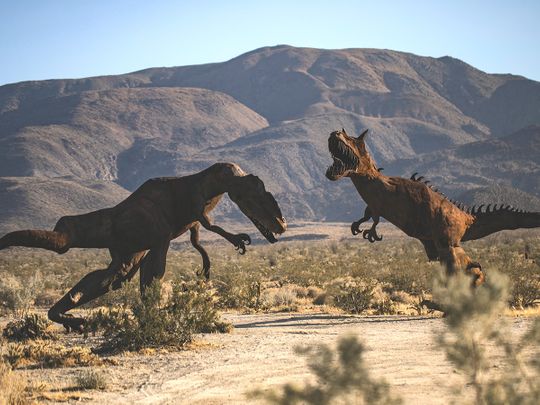
We’ve all learned fascinating facts about dinosaurs in school. But these mysterious creatures are a lot more interesting than we realise.
Click start to play today’s Crossword, where you can spot one of the most well-known dinosaurs in the clues.
With extensive investigations and recent dinosaur discoveries reshaping much of what the public had once thought about these giant creatures, some of the facts you learn here may actually surprise you.
Here are five that blew our minds:
1. Mindboggling time span
The stegosaurus lived during the late Jurassic period, roughly 150 million years ago. The tyrannosaurus rex, on the other hand, lived in the Cretaceous period, about 65 million years ago. With a little maths, you would have realised that there’s a time difference of nearly 80 million years between them! This time span is longer than the period of time separating the T-rex from humans.
2. The blue whale is still the largest
The largest dinosaur (and largest land animal) ever discovered is the argentinosaurus, named after Argentina, where it was found in 1987. Fossils of the gigantic creature allowed paleontologists to deduce that it was more than 130 feet long, and weighed between 70 and 80 tonnes. Even with such massive proportions, the Argentinosaurus still wasn’t as large as the blue whale, which swims in the world’s oceans today. These aquatic mammals can reach 100 feet in length and weight more than 191 tonnes. While the long neck of the argentinosaurus helps it edge ahead of the blue whale in terms of total length, the blue whale is still generally considered to be the biggest animal of all time, based on sheer girth and weight.
3. The Earth moved differently during the age of dinosaurs
Every year, the Earth slows down a little more as it rotates on its axis. While the difference may only be in milliseconds, millions of years have caused those moments to add up. About 200 million years ago, when dinosaurs roamed the Earth, the average day was about 23 hours long, and each year on our planet lasted 385 days.
4. A dinosaur could break the sound barrier with its tail
The apatosaurus lived 150 million years ago, and its remarkable 90-foot length ended in a 12-foot-long tail. According to an October 2015 report in the US-based science news website LiveScience, scientists created a computer simulation, and a model tail made of aluminum, stainless steel, neoprene, and Teflon, to show how the apatosaurus was likely able to create sonic booms when it slapped its tail to the ground. The dinosaur was thought to do this when it needed to defend itself, communicate or court another dinosaur. No doubt, it got others’ attention.
5. Many dinosaurs had feathers
When this bit of research came out in recent years, it shocked the public. After all, dinosaurs have been depicted as reptilian creatures with scales, since the beginning of paleontology. However, recent discoveries have uncovered a large number of dinosaurs with feathers instead. Some had elaborate, colourful plumes, according to the US-based Smithsonian Magazine, causing them to resemble flamingoes, peacocks, and in the case of the Caihong juji (found in China), a cross between a hummingbird and crow.
What do you think of these dino facts? Play today’s Crossword and tell us at games@gulfnews.com.






